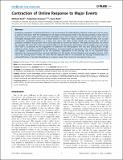Contraction of Online Response to Major Events
Author(s)
Szell, Michael; Ratti, Carlo; Grauwin, Sebastian
DownloadSzell-2014-Contraction of onlin.pdf (1.219Mb)
PUBLISHER_CC
Publisher with Creative Commons License
Creative Commons Attribution
Terms of use
Metadata
Show full item recordAbstract
Quantifying regularities in behavioral dynamics is of crucial interest for understanding collective social events such as panics or political revolutions. With the widespread use of digital communication media it has become possible to study massive data streams of user-created content in which individuals express their sentiments, often towards a specific topic. Here we investigate messages from various online media created in response to major, collectively followed events such as sport tournaments, presidential elections, or a large snow storm. We relate content length and message rate, and find a systematic correlation during events which can be described by a power law relation—the higher the excitation, the shorter the messages. We show that on the one hand this effect can be observed in the behavior of most regular users, and on the other hand is accentuated by the engagement of additional user demographics who only post during phases of high collective activity. Further, we identify the distributions of content lengths as lognormals in line with statistical linguistics, and suggest a phenomenological law for the systematic dependence of the message rate to the lognormal mean parameter. Our measurements have practical implications for the design of micro-blogging and messaging services. In the case of the existing service Twitter, we show that the imposed limit of 140 characters per message currently leads to a substantial fraction of possibly dissatisfying to compose tweets that need to be truncated by their users.
Date issued
2014-02Department
Massachusetts Institute of Technology. Department of Urban Studies and Planning; Massachusetts Institute of Technology. SENSEable City LaboratoryJournal
PLoS ONE
Publisher
Public Library of Science
Citation
Szell, Michael, Sébastian Grauwin, and Carlo Ratti. “Contraction of Online Response to Major Events.” Edited by Jesus Gomez-Gardenes. PLoS ONE 9, no. 2 (February 26, 2014): e89052.
Version: Final published version
ISSN
1932-6203